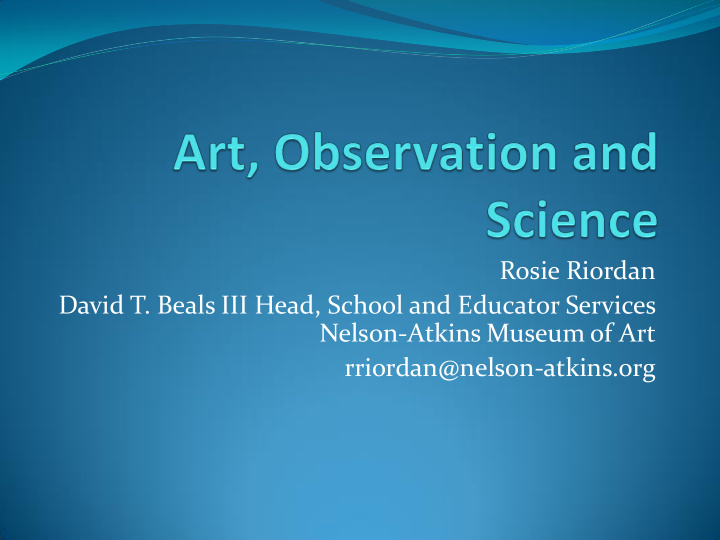



Rosie Riordan David T. Beals III Head, School and Educator Services Nelson-Atkins Museum of Art rriordan@nelson-atkins.org
To SEE: Removing the symbols…… Training your eyes and your brain to see what is there Learning to look closely and pay attention to detail
Training your brain to see……
Blind Contour….. Dominant, & Non Dominant Hand (Not looking at paper, place pencil on paper and draw using one continuous line, no peeking, no stopping)
Gesture……. (quick sketch to capture movement, general impression of object)
Memory….. (Study object for one minute, memorizing what it looks like, then get your paper and pencil and draw it in as much detail as possible)
VTS, Visual Thinking Strategies Learning to look closely…. Causes students to really hone in on the details…. Be respectful, collaborate and build on others ideas Persevere and develop stamina and confidence…. Starts where students are and builds on their experience…..
What VTS requires of students/viewers: • LOOK CAREFULLY at works of art • DISCUSS observations democratically • Support ideas with EVIDENCE • LISTEN to views of others • CONSIDER many possible interpretations
What is VTS? 3 questions: What is going on in this image? What did you see that made you say that? What more can we find? Paraphrasing and pointing Neutrality Observation Collaboration
What does VTS do? Reinforces Observing, Inferring, Communicating — process skills for scientific thinking “Take a minute to look”— Scanning, noticing, writing “What’s going on here?”— Lingering, communicating “What do you see that makes you say that?”— “what evidence do you have?” (based on visual evidence or prior knowledge) Making connections — look at observations, make connections to standards or curricula Paraphrasing – using graphic organizers to integrate understanding, spiraling in literacy Benefits — assessment tool, integrates literacy, learner-driven, generates ideas for inquiry or later projects
VTS Training We offer 2 day trainings at the Nelson-Atkins, cost is $150.00, check our website for dates. We offer PD for teachers at the museum or at your school. We have workshops that incorporate STEM, light painting, Scribble bots and Automatons. We offer Design Thinking and a teacher kit called Jump In
Stem to Steam: Tinkering 12/17/2015 16
Any Questions? Further information: rriordan@nelson-atkins.org 816-751-1398
Recommend
More recommend